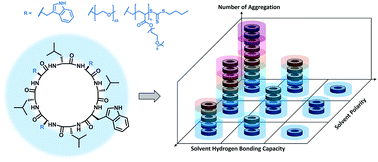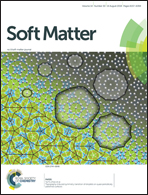Systematic study of the structural parameters affecting the self-assembly of cyclic peptide–poly(ethylene glycol) conjugates†
Abstract
Self-assembling cyclic peptides (CP) consisting of amino acids with alternating D- and L-chirality form nanotubes by hydrogen bonding, hydrophobic interactions, and π–π stacking in solution. These highly dynamic materials are emerging as promising supramolecular systems for a wide range of biomedical applications. Herein, we discuss how varying the polymer conformation (linear vs. brush), as well as the number of polymer arms per peptide unimer affects the self-assembly of PEGylated cyclic peptides in different solvents, using small angle neutron scattering. Using the derived information, strong correlations were drawn between the size of the aggregates, solvent polarity, and its ability to compete for hydrogen bonding interactions between the peptide unimers. Using these data, it could be possible to engineer cyclic peptide nanotubes of a controlled length.



 Please wait while we load your content...
Please wait while we load your content...